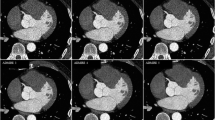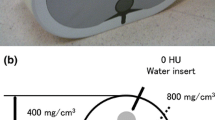Abstract
Purpose
This study was performed to confirm, by propensity score matching, whether the use of adaptive–iterative dose reduction (AIDR 3D) with a built-in automatic exposure control system provides clinical and dosimetric advantages with respect to the traditional filtered back-projection (FBP) algorithm without automatic exposure modulation.
Materials and methods
A total of 200 consecutive patients undergoing coronary computed tomography (CT) angiography on a 640-slice CT scanner were studied. A protocol with exposure parameters based on patient body mass index (BMI) and with images reconstructed using FBP (group A) was compared with a protocol with images acquired using tube current decided by an automatic exposure control system and reconstructed using AIDR (group B). Mean effective dose and image quality with both objective and subjective measurements were assessed.
Results
Mean effective dose was 23.6 % lower in group B than in group A (2.56 versus 3.34 mSv; p < 0.0001). Noise was significantly lower in group B with consequent higher signal-to-noise (SNR) and contrast-to-noise (CNR) (p < 0.0001) compared with group A. Subjective quality parameters were also significantly higher in group B.
Conclusions
Comparative analysis by propensity score matching confirms that AIDR 3D with automatic exposure control is able to reduce significantly the mean radiation dose and improve the image quality compared with traditional FBP without exposure modulation.

Similar content being viewed by others
References
Lloyd-Jones D, Adams RJ, Brown TM et al (2010) Executive summary: heart disease and stroke statistics—2010 update: a report from the American Heart Association. Circulation 121:948–954
Einstein AJ, Henzlova MJ, Rajagopalan S (2007) Estimating risk of cancer associated with radiation exposure from 64-slice computed tomography coronary angiography. JAMA 298:317–323
Hamon M, Biondi-Zoccai GG, Malagutti P et al (2006) Diagnostic performance of multislice spiral computed tomography of coronary arteries as compared with conventional invasive coronary angiography: a meta-analysis. J Am Coll Cardiol 48:1896–1910
Di Cesare E, Carbone I, Carriero A et al (2012) Clinical indications for cardiac computed tomography. From the Working Group of the Cardiac Radiology Section of the Italian Society of Medical Radiology (SIRM). Radiol Med 117:901–938
Hausleiter J, Meyer T, Hermann F et al (2009) Estimated radiation dose associated with cardiac CT angiography. JAMA 301:500–507
Labounty TM, Earls JP, Leipsic J et al (2010) Effect of a standardized quality-improvement protocol onradiation dose in coronary computed tomographic angiography. Am J Cardiol 106:1663–1667
Tomizawa N, Nojo T, Akahane M et al (2012) Adaptive iterative dose reduction in coronary CT angiography using 320-row CT: assessment of radiation dose reduction and image quality. J Cardiovasc Comput Tomogr 6:318–324
Yoo RE, Park EA, Lee W et al (2013) Image quality of adaptive iterative dose reduction 3D of coronary CT angiography of 640-slice CT: comparison with filtered back-projection. Int J Cardiovasc Imaging 29:669–676
Williams MC, Weir NW, Mirsadraee S et al (2013) Iterative reconstruction and individualized automatic tube current selection reduce radiation dose while maintaining image quality in 320-multidetector computed tomography coronary angiography. Clin Radiol 68:e570–e577
Chun EJ, Lee W, Choi YH et al (2008) Effects of nitroglycerin on the diagnostic accuracy of electrocardiogram-gated coronary computed tomography angiography. J Comput Assist Tomogr 32:86–92
Austen WG, Edwards JE, Roe BB et al (1975) A reporting system on patients evaluated for coronary artery disease. Report of the Ad Hoc Committee for Grading of Coronary Artery Disease, Council on Cardiovascular Surgery, American Heart Association. Circulation 51:5–40
Leipsic J, Labounty TM, Heilbron B et al (2010) Adaptive statistical iterative reconstruction: assessment of image noise and image quality in coronary CT angiography. AJR Am J Roentgenol 195:649–654
Park EA, Lee W, Kim KW et al (2011) Iterative reconstruction of dual-source coronary CT angiography: assessment of image quality and radiation dose. Int J Cardiovasc Imaging 28:1775–1786
Bittencourt MS, Schmidt B, Seltmann M et al (2011) Iterative reconstruction in image space (IRIS) in cardiac computed tomography: initial experience. Int J Cardiovasc Imaging 27:1081–1087
Hara AK, Paden RG, Silva AC et al (2009) Iterative reconstruction technique for reducing body radiation dose at CT: feasibility study. AJR Am J Roentgenol 193:764–771
Bongartz G, Golding SJ, Jurik AG et al (2004) European Commission Website. European guidelines for multislice computed tomography: appendix C. Funded by the European Commission, March 2004. Contract No. FIGM-CT2000-20078-CT TIP
Rubin DB (1997) Estimating causal effects from large data sets using propensity scores. Ann Intern Med 127(8 Pt 2):757–763
Cohen J (1960) A coefficient of agreement for nominal scales. Educ Psychol Meas 20:37–46
Hoe J, Toh KH (2009) First experience with 320-row multidetector CT coronary angiography scanning with prospective electrocardiogram gating to reduce radiation dose. J Cardiovasc Comput Tomogr 3:257–261
Dewey M, Zimmermann E, Hamm B et al (2009) Non invasive coronary angiography by 320-row computed tomography with lower radiation exposure and maintained diagnostic accuracy: comparison of results with cardiac catheterization in a head-to-head pilot investigation. Circulation 120:867–875
Lee CH, Goo JM, Ye HJ et al (2008) Radiation dose modulation techniques in the multidetector CT era: from basics to practice. Radiographics 28:1451–1459
Chen MY, Steigner ML, Leung SW et al (2013) Simulated 50% radiation dose reduction in coronary CT angiography using adaptative iterative dose reduction in three-dimensions. Int J Cardiovasc Imaging 29:1167–1175
Silva AC, Lawder HJ, Hara A et al (2010) Innovations in CT dose reduction strategy: application of the adaptative statistical iterative reconstruction algorithm. AJR 194:191–199
Cademartiri F, La Grutta L, Runza G et al (2007) Influence of convolution filtering on coronary plaque attenuation values: observations in an ex vivo model of multislice computed tomography coronary angiography. Eur Radiol 17:1842–1849
La Grutta L, Galia M, Gentile G et al (2013) Comparison of iodinated contrast media for the assessment of atherosclerotic plaque attenuation values by CT coronary angiography: observations in an ex vivo model. Br J Radiol 86:20120238
Acknowledgments
The present work benefited from the input of Dr. Eng. Alessandro Zappata, of Toshiba Medical System, who provided valuable assistance to the undertaking of the research summarised here.
Conflict of interest
Ernesto Di Cesare, Antonio Gennarelli, Alessandra Di Sibio, Valentina Felli, Alessandra Splendiani, Giovanni Luca Gravin, Antonio Barile and Carlo Masciocchi declare no conflict of interest.
Author information
Authors and Affiliations
Corresponding author
Rights and permissions
About this article
Cite this article
Di Cesare, E., Gennarelli, A., Di Sibio, A. et al. Assessment of dose exposure and image quality in coronary angiography performed by 640-slice CT: a comparison between adaptive iterative and filtered back-projection algorithm by propensity analysis. Radiol med 119, 642–649 (2014). https://doi.org/10.1007/s11547-014-0382-3
Received:
Accepted:
Published:
Issue Date:
DOI: https://doi.org/10.1007/s11547-014-0382-3




